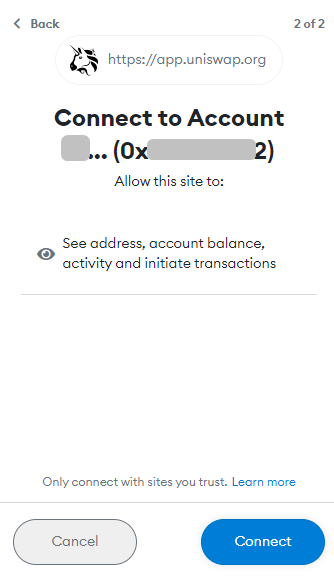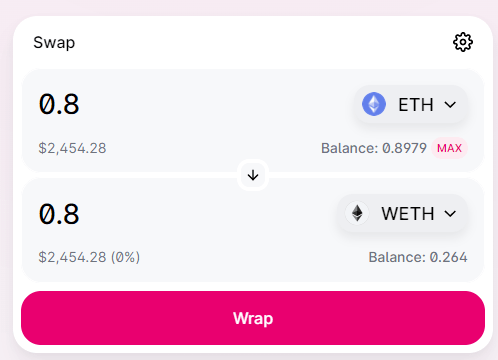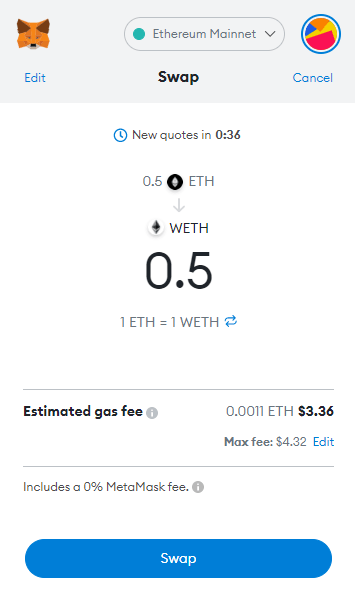Summary
Wrapped Ethereum (ETH) is a token pegged to Ethereum (ETH). Wrapped Ethereum is available on numerous platforms and decentralized applications that support ERC-20 tokens. While Ethereum can be used to pay network transaction fees, its functionality is different from ERC-20 tokens.
You can easily convert Ethereum into Wrapped Ethereum through the wrapping process. You can also exchange wrapped ether back for ether at any time. Both wrapping and unwrapping follow a 1:1 ratio, meaning there are no additional fees other than transaction fees.
You can manually wrap your ether by interacting with the wrapped ether smart contract, which will store your ether and return an equal amount of wrapped ether.
Ethereum’s decentralized finance (DeFi) ecosystem is quite large, and the use of wrapped Ethereum provides more opportunities for staking investments. There are many versions of wrapped Ethereum, but some are more popular than others. You can even find wrapped Ethereum on other blockchains, available for use in their ecosystems. Mainstream uses for wrapped ether include NFT trading, injecting liquidity into liquidity pools, and for cryptocurrency lending.
Introduction
If you use Ethereum, most of the tokens you trade and invest in will probably use ERC -20 tokens standard. Adopting this technical standard has become a mainstream choice for decentralized applications, wallets, and projects because of the utility it provides to the majority of users. However, this status quo poses problems for Ethereum’s native token, Ethereum.
Ethereum does not follow the same rules as ERC-20 tokens, but there is also demand for use in ERC-20 decentralized applications. Wrapped Ethereum came into being, which you may already know. Let’s take a look at the reasons why it has become a practical tool for investors and holders of many projects and decentralized applications.

What is Wrapped Ethereum (WETH)?
Wrapped Ethereum is an ERC-20 token on Ethereum that is pegged to the price of Ethereum (ETH). While Ethereum’s native token, Ether, can be used to pay for gas, wrapped Ethereum cannot. However, wrapped ether has a wider range of uses than ether and is quite popular in the decentralized finance (DeFi) ecosystem. MetaMask, TrustWallet, and almost every wallet in the Ethereum network will support wrapped ether. Let’s explore some of its uses.
Why do we need to wrap Ethereum?
At first, it was confusing why a token like wrapped Ethereum existed. Doesn’t the Ethereum blockchain already have Ethereum? The first thing to understand is that not every token on Ethereum is technically similar. The network allows developers to create new rules and standards for cryptocurrencies.
One example is in the form of ERC-721, which gives us non-fungible tokens (NFTs). These are all very different from Ethereum or ERC-20 tokens. Developers have a lot of room for customization when creating these digital assets. So while Ethereum can be used to pay for gas on Ethereum, Ethereum cannot be used in all decentralized applications.
Today, most DeFi decentralized applications accept ERC-20 tokens for investment and staking. If you want to inject ether into liquidity pools or use it as collateral, it will be much easier to do so in the ERC-20 version. This provides maximum compatibility across the entire blockchain and saves time in developing new smart contracts.
How to wrap Ethereum (ETH)?
The process of generating wrapped ether is simple - send ether to a smart contract and receive wrapped ether in return. That is, all wrapped Ethereum created is fully guaranteed by the Ethereum reserve. Your ether is locked in a smart contract and can be exchanged back for wrapped ether at any time. When your ether is returned, the contract destroys the wrapped ether provided.
To wrap ether, you can interact directly with the wrapped ether smart contract, and your ether and wrapped ether will be credited to the wallet at a 1:1 ratio (you still need to pay for the transaction fee). Converting back requires interacting with another smart contract, but the process is almost the same.
However, it is much easier to exchange another token for wrapped ether through a cryptocurrency exchange. Let’s look at how to exchange ether for wrapped ether using the Uniswap decentralized exchange or directly through the Metamask wallet.
Wrapping Ethereum in Uniswap
1. Open Uniswap and connect your wallet. Make sure to also select Ethereum as the network.


2. Select Ethereum in the top field and Wrap Ethereum at the bottom. Click [Select Token] and you will see wrapped Ethereum at the top of the list.

3. Enter the amount of Ether coins you want to exchange for wrapped Ether coins, and click the [Exchange] button.

4. Now you need to confirm the transaction in your cryptocurrency wallet. Don’t forget, you’ll also need to pay for gas, so make sure you have extra ether left. Check the transaction details and click [Confirm].

5. Now you just need to wait for the transaction to be confirmed in the blockchain. Waiting time will depend on current network traffic. If you're pressed for time, you can accelerate your transaction (i.e. pay a higher fee) so it's confirmed faster.
Wrapping Ethereum in MetaMask
1. Open your MetaMask wallet and make sure the network is [Ethereum Mainnet]. Then, click [Redeem].

2. In the [Redeem to] field, search for WETH.

3. Enter the amount of Ether coins to be exchanged and click [View Exchange].

4. Now you will see the price tag showing the exchange rate (should be 1:1). Click [Exchange] to complete the transaction.

How to wrap Ethereum (WETH)?
As mentioned before, you can manually unwrap Ether by interacting with a smart contract. However, it is simpler and safer to exchange wrapped ether for ether. To do this, follow the previous Uniswap or MetaMask instructions, but make sure you are switching from wrapped Ethereum to Ethereum. You can also convert wrapped Ethereum via Binance.
1. Go to the Binance Switching and OTC Trading Portal. Select Wrapping Ethereum in the [From] field, select Ethereum in the [To] field, and click [Preview Conversion].

2. Now you will see the transaction details. Please confirm transaction details before accepting redemption. Please note that Binance does not allow you to exchange ether for wrapped ether using this method.
Can Ethereum be wrapped on other blockchains?
Other wrapped versions of Ethereum exist in mainstream blockchains, which increases Ethereum’s interoperability. For example, using wrapped ether on Binance Smart Chain (BSC) allows you to trade or use wrapped ether in the Binance Smart Chain (BSC) decentralized finance ecosystem. To do this, you need to withdraw ether from Binance or another exchange to a Binance Smart Chain (BSC) wallet. Before withdrawing, make sure your exchange supports converting from Ethereum to Wrapped Ethereum.
You can also use a bridging service. These are third-party decentralized applications that take cryptocurrencies and store them on the original blockchain, then mint wrapped tokens on the target blockchain at a 1:1 ratio.
Bridge tokens generally work well, but be aware that transferring tokens across blockchains can be risky. In some cases, partial bridging can compromise smart contracts. If you want to bridge wrapped Bitcoin, wrapped Ethereum, or other tokens, carefully research the platform you are using before using a bridging service.
How does the price of wrapped ether align with the price of ether?
The key to maintaining the peg between wrapped ether and ether is 1:1 convertibility. If wrapped ether is cheaper, people will buy it and exchange it for more expensive ether, making a profit. This will increase the demand for wrapped ether, thus increasing the price. If wrapped ether is more expensive, people will buy ether and exchange it for wrapped ether to sell, thereby increasing the supply of wrapped ether and lowering its price. These supply and demand principles ensure that the peg remains relatively stable.
In which DeFi decentralized applications can wrapped Ethereum be used?
Ethereum has many DeFi decentralized applications that accept ERC-20 tokens to explore. One option is to inject wrapped ether into a liquidity pool for use on a decentralized exchange (DEX) such as Uniswap. Once you provide liquidity, you can start earning fees from users who redeem their tokens using the pool. However, impermanent losses are always a possible risk and may result in a reduction in the number of tokens you deposit. Using a pool with greater liquidity will reduce this risk.
You can also lend your wrapped ether on platforms like Aave. Other users can borrow your tokens but must first provide collateral to secure the loan. In return, you will earn interest until you decide to withdraw your deposit.

Conclusion
Ethereum has the longest and most mature One of the centralized application ecosystems. This makes wrapped ether a necessity as many ether holders want to use ether in DeFi projects. If you decide to start experimenting with wrapped Ethereum, we recommend that you buy it using Ethereum or other tokens, which is simpler and more convenient than interacting with wrapped smart contracts.
 Forum
Forum OPRR
OPRR Finance
Finance
 Specials
Specials
 On-chain Eco
On-chain Eco
 Entry
Entry
 Podcasts
Podcasts
 Data
Data
